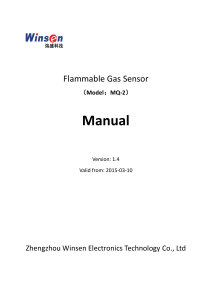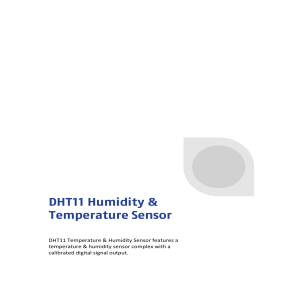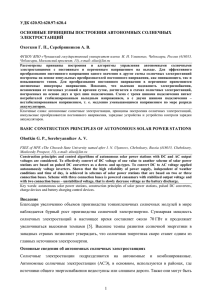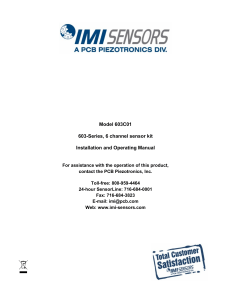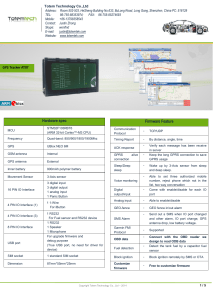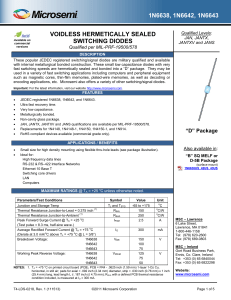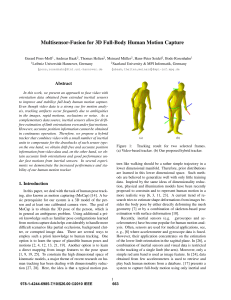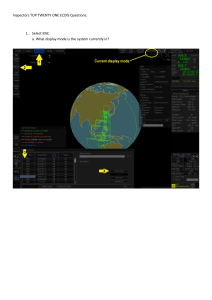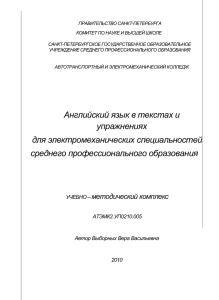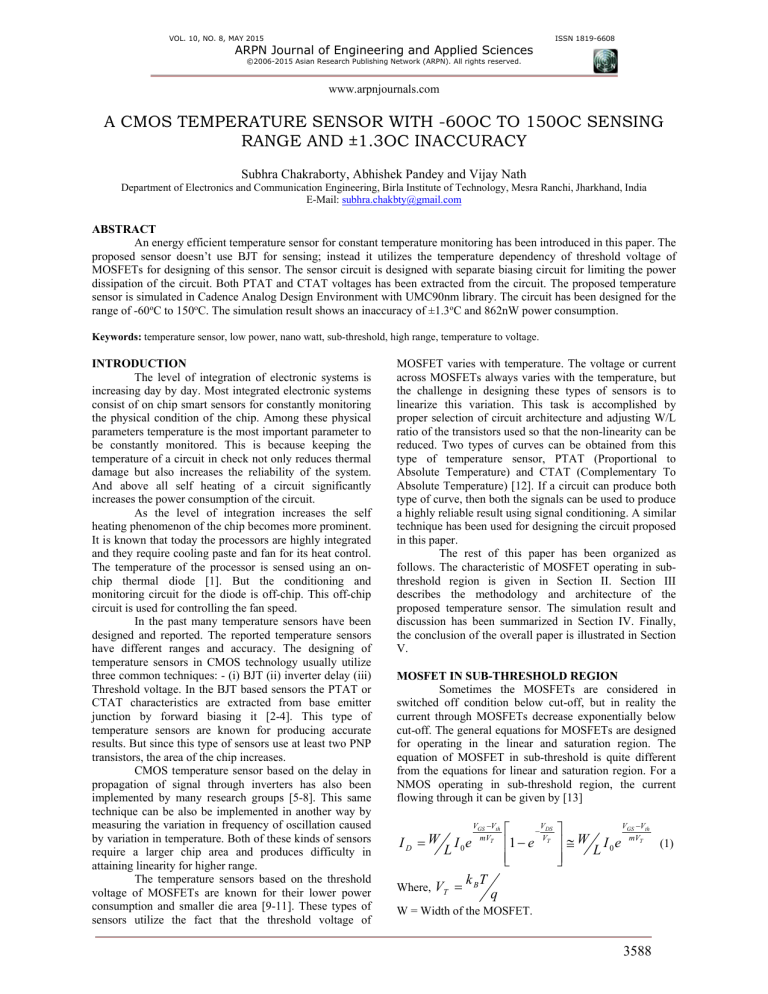
VOL. 10, NO. 8, MAY 2015 ISSN 1819-6608 ARPN Journal of Engineering and Applied Sciences ©2006-2015 Asian Research Publishing Network (ARPN). All rights reserved. www.arpnjournals.com A CMOS TEMPERATURE SENSOR WITH -60OC TO 150OC SENSING RANGE AND ±1.3OC INACCURACY Subhra Chakraborty, Abhishek Pandey and Vijay Nath Department of Electronics and Communication Engineering, Birla Institute of Technology, Mesra Ranchi, Jharkhand, India E-Mail: subhra.chakbty@gmail.com ABSTRACT An energy efficient temperature sensor for constant temperature monitoring has been introduced in this paper. The proposed sensor doesn’t use BJT for sensing; instead it utilizes the temperature dependency of threshold voltage of MOSFETs for designing of this sensor. The sensor circuit is designed with separate biasing circuit for limiting the power dissipation of the circuit. Both PTAT and CTAT voltages has been extracted from the circuit. The proposed temperature sensor is simulated in Cadence Analog Design Environment with UMC90nm library. The circuit has been designed for the range of -60oC to 150oC. The simulation result shows an inaccuracy of ±1.3oC and 862nW power consumption. Keywords: temperature sensor, low power, nano watt, sub-threshold, high range, temperature to voltage. INTRODUCTION The level of integration of electronic systems is increasing day by day. Most integrated electronic systems consist of on chip smart sensors for constantly monitoring the physical condition of the chip. Among these physical parameters temperature is the most important parameter to be constantly monitored. This is because keeping the temperature of a circuit in check not only reduces thermal damage but also increases the reliability of the system. And above all self heating of a circuit significantly increases the power consumption of the circuit. As the level of integration increases the self heating phenomenon of the chip becomes more prominent. It is known that today the processors are highly integrated and they require cooling paste and fan for its heat control. The temperature of the processor is sensed using an onchip thermal diode [1]. But the conditioning and monitoring circuit for the diode is off-chip. This off-chip circuit is used for controlling the fan speed. In the past many temperature sensors have been designed and reported. The reported temperature sensors have different ranges and accuracy. The designing of temperature sensors in CMOS technology usually utilize three common techniques: - (i) BJT (ii) inverter delay (iii) Threshold voltage. In the BJT based sensors the PTAT or CTAT characteristics are extracted from base emitter junction by forward biasing it [2-4]. This type of temperature sensors are known for producing accurate results. But since this type of sensors use at least two PNP transistors, the area of the chip increases. CMOS temperature sensor based on the delay in propagation of signal through inverters has also been implemented by many research groups [5-8]. This same technique can be also be implemented in another way by measuring the variation in frequency of oscillation caused by variation in temperature. Both of these kinds of sensors require a larger chip area and produces difficulty in attaining linearity for higher range. The temperature sensors based on the threshold voltage of MOSFETs are known for their lower power consumption and smaller die area [9-11]. These types of sensors utilize the fact that the threshold voltage of MOSFET varies with temperature. The voltage or current across MOSFETs always varies with the temperature, but the challenge in designing these types of sensors is to linearize this variation. This task is accomplished by proper selection of circuit architecture and adjusting W/L ratio of the transistors used so that the non-linearity can be reduced. Two types of curves can be obtained from this type of temperature sensor, PTAT (Proportional to Absolute Temperature) and CTAT (Complementary To Absolute Temperature) [12]. If a circuit can produce both type of curve, then both the signals can be used to produce a highly reliable result using signal conditioning. A similar technique has been used for designing the circuit proposed in this paper. The rest of this paper has been organized as follows. The characteristic of MOSFET operating in subthreshold region is given in Section II. Section III describes the methodology and architecture of the proposed temperature sensor. The simulation result and discussion has been summarized in Section IV. Finally, the conclusion of the overall paper is illustrated in Section V. MOSFET IN SUB-THRESHOLD REGION Sometimes the MOSFETs are considered in switched off condition below cut-off, but in reality the current through MOSFETs decrease exponentially below cut-off. The general equations for MOSFETs are designed for operating in the linear and saturation region. The equation of MOSFET in sub-threshold is quite different from the equations for linear and saturation region. For a NMOS operating in sub-threshold region, the current flowing through it can be given by [13] ID W L I 0e Where, VT VGS Vth mVT k BT V DS VT 1 e VGS Vth mVT W I e (1) 0 L q W = Width of the MOSFET. 3588 VOL. 10, NO. 8, MAY 2015 ISSN 1819-6608 ARPN Journal of Engineering and Applied Sciences ©2006-2015 Asian Research Publishing Network (ARPN). All rights reserved. www.arpnjournals.com L = Length of the MOSFET. VGS = Gate to source voltage applied to the transistor. VDS = Drain to source voltage applied to the transistor. Io = Process dependent parameter. Vth = Threshold voltage. m = Sub-threshold slope parameter. kB = Boltzmann constant. q = Elementary charge. T = Absolute temperature. Again the Vth can be written as N Vth Vth 0 2VT ln A ni (2) Where, Vth0 = Threshold voltage at zero body to source voltage. NA = Carrier concentration. ni = Intrinsic carrier concentration. When the threshold voltage Vth is considered, another important phenomenon comes into play, called the DIBL (drain-induced barrier lowering) effect. At high drain voltages a reduced threshold voltage is encountered due to this effect. Using the above written current equation, the trans-conductance and drain-source resistance of NMOS in sub-threshold region can be given as. gm I D I D VGS mVT I rd D VDS mVT D I D as active resistors. These transistors have been connected in differential connection to utilize the difference in current flow with respect to temperature using current mirror through transistors M3, M4 and M9, M10. This same current mirror helps in obtaining the voltage due to difference in current flow. The current mirror used in this circuit doesn’t actually mirror the current flowing in one of the sides to another, but it actually mirrors the amplified or attenuated current with respect to the W/L ratio of the transistors. This is done so that a linear result can be obtained from output. The W/L ratios of the transistors configured as active resistors are also suitably adjusted for linearization of the output voltages. The transistors connected above and below the differential connection M5, M6 and M11, M12 are important in terms of controlling the output voltage range of the sensor with respect to the temperature range. This output voltage range is given by the W/L ratios of these transistors. But again these transistors also control the power consumption of the circuit with the help of the biasing transistors Mb1, Mb2, Mb3, Mb4, Mb5 and Mb6. These many transistors have been connected in series to reduce the biasing current of the circuit. The biasing current for any threshold voltage based temperature sensor should be optimized properly because it not only limits the power consumption of the circuit but also defines the upper limit of the temperature to be sensed. For these designs the power supply voltages are also important because they also can limit the temperature sensing range. (3) (4) Where, λD = DIBM coefficient. PROPOSED TEMPERATURE SENSOR When a MOS transistor is configured as an active resistor, if its small signal model is considered, the resistance exhibited by the transistor is 1/gm. And while operating in sub-threshold region the output resistance of the MOSFET can be written as ro mVT m k BT 1 gm ID ID q (5) From the above equation it can be concluded that the output resistance of a MOSFET configured as an active resistor is directly related to its temperature. In the proposed temperature sensor circuit given in Fig.1 both PTAT (Proportional to Absolute Temperature) and CTAT (Complementary to Absolute Temperature) voltages has been extracted. In the proposed design the transistors M1, M2, M7 and M8 are configured Figure-1. Proposed temperature sensor. SIMULATION RESULTS The temperature sensor proposed in this paper has been simulated in Analog Design Environment of Cadence using UMC90nm library. The proposed circuit uses a ±0.5V supply. Both PTAT and CTAT characteristics have been extracted from the circuit, however the CTAT characteristics shows superior results than PTAT. The proposed circuit has been designed for sensing temperature from -60oC to 150oC. The PTAT voltage, Vptat gives an output voltage of -88.0683mV at 60oC and 236.665mV at 150oC. The sensitivity for Vptat is 1.54635mV/oC. The CTAT voltage, Vctat shows an output 3589 VOL. 10, NO. 8, MAY 2015 ISSN 1819-6608 ARPN Journal of Engineering and Applied Sciences ©2006-2015 Asian Research Publishing Network (ARPN). All rights reserved. www.arpnjournals.com voltage of 100.595mV to -157.838mV for the temperature range of -60oC to 150oC with a sensitivity of 1.23063mV/oC. Both Vptat and Vctat curves has been shown in Figure-2. much better result in terms of accuracy. The error curves for both Vptat and Vctat are given in Figure-3. The circuit has been simulated at different process corners to get the worst operating conditions. The circuit has been simulated in five different process corners tt, ss, ff, snfp and fnsp. The simulation result is shown in Fig. 4. From the result it can be observed that the ff and snfp corner shows the worst result for the designed circuit. It is known that the power consumption of any CMOS circuit increases with increasing temperature. Figure-2. Vptat and Vctat of the proposed temperature sensor. Figure-4. Vptat and Vctat at different process corners. Figure-3. Vptat error and Vctat error of the proposed temperature sensor. The inaccuracy of any temperature sensor is given as the maximum deviation from actual value at any given temperature in between the specified range of the sensor. For the specified range of the given sensor the Vptat shows an inaccuracy of ±2.13oC, while the Vctat shows a lower inaccuracy of ±1.3oC. So, the Vctat shows a Table-5. Power consumption of the proposed temperature sensor. 3590 VOL. 10, NO. 8, MAY 2015 ISSN 1819-6608 ARPN Journal of Engineering and Applied Sciences ©2006-2015 Asian Research Publishing Network (ARPN). All rights reserved. www.arpnjournals.com Table-1. Performance comparison of proposed sensor with previously designed temperature sensors table type styles. Parameter [9] [14] [15] [16] [12] Technology (nm) Power supply (V) Temperature range (oC) 1000 180 90 180 180 Proposed circuit 90 1 1 1 0.6- 2.5 - 1 +10 to +100 +1 +50 to +125 +0.8, 1 +10 to +120 Inaccuracy (oC) -10 to +30 +0.8, 1 -45 to +85 +1.8, 0.9 Power consumption (W) 100u 119n 25u 7n The overall resultant power dissipation of the proposed sensor with increasing temperature is given in Figure-5. The curve shows maximum power dissipation of 862nW at 150oC and 216nW at room temperature. In Table-1 the proposed temperature sensor has been compared with previously designed circuits. The Vctat from the designed sensor is chosen for comparison as it produces better result than Vptat. From the table it can be observed that the circuit senses for a larger range. Generally for CMOS temperature sensor utilizing threshold voltage of MOSFET for sensing, the inaccuracy increases with range. But, the proposed design keeps the inaccuracy in check, well within ±1.3oC. Also the power consumption of the circuit is on the lower side. CONCLUSIONS The temperature sensor circuit presented in this paper utilizes the variation in threshold voltage with temperature to produce PTAT and CTAT voltage signal. The CTAT voltage produces better result in terms of accuracy for the designed sensor. The voltage sensitivity per degree centigrade of the designed sensor is also quite high. Moreover the circuit senses for temperature range of -60oC to 150oC, which is spread over 210 degrees. The accuracy of the circuit is also quite good with respect to the temperature range. The power dissipation of the circuit is also on the lower side, which is well under 1uW. Since the proposed sensor senses for a widespread range of temperature with satisfactory accuracy the sensor can find its application in military and aerospace applications. REFERENCES [1] AMD Functional Data Sheet, 940 Pin Package Jun. 2004, Advanced Micro Devices, Inc., 31412, Rev 3.05. [2] Pertijs, M. A. P., Meijer, G. C. M., and Huijsing, J. H., “Precision temperature measurement using CMOS substrate pnp transistors.” IEEE Sensors Journal, vol. 4, no. 3, pp. 294–300, 2004. +2 478u -60 to +150 +1.3 862n [3] A.L. Aita, M.A.P. Pertijs, K.A.A. Makinwa, J.H. Huijsing, “A CMOS smart temperature sensor with a batch-calibrated inaccuracy of ±0.25 ◦ C (3σ) from 70 ◦ C to 130 ◦C,” IEEE Int. Solid-State Circuits Conf. (ISSCC) Dig. Tech. Papers, pp. 342–343, 2009. [4] M. Pertijs, K. Makinwa, and J.Huijsing, “A CMOS Temperature Sensor with a 3 sigma Inaccuracy of 0.1C from -55°C to 120°C.” IEEE J. Solid-State Circuits, vol. 40, no.12, pp. 2805-2815, December 2005. [5] P. Chen, C. Chen, C. Tsai, and W. Lu, “A Time-to Digital Converter Based CMOS Smart Temperature sensor.” IEEE J. Solid-State Circuits, vol. 40, no.8, pp. 1642-1648, August 2005. [6] K. Woo, S. Meninger, T. Xanthopoulos, E. Crain, D. Ha, and D. Ham, “Time-domain CMOS temperature sensors with dual delay-locked loops for microprocessor thermal monitoring,” IEEE Trans. Very Large Scale Integr. (VLSI) Syst., vol. 20, no. 9, pp. 1590–1601, September 2012. [7] K. Kim, H. Lee, and C. Kim, “366-Ks/s 1.09-nJ 0.0013-mm2 frequencyto-digital converter based CMOS temperature sensor utilizing multiphase clock,” IEEE Trans. Very Large Scale Integr. (VLSI) Syst., vol. 20, no. 12, pp. 1–5, December 2012. [8] K. Arabi and B. Kaminska, “Built-in temperature sensors for on-line thermal monitoring of microelectronic structures,” Proc. IEEE International Conference on Computer Design, pp. 462-467, 1997. [9] V. Szekely, Cs. Marta, Zs. Kohari, and M. Rencz, “CMOS Sensors for On-Line Thermal Monitoring of VLSI Circuits,” IEEE Trans. Very Large Scale Integration Systems, vol. 5, no. 3, pp. 270-276, September 1997. [10] M. Sasaki, M. Ikeda, K. Asada, “A Temperature Sensor with an Inaccuracy of -1/+0.8°C using 90nm 1- 3591 VOL. 10, NO. 8, MAY 2015 ISSN 1819-6608 ARPN Journal of Engineering and Applied Sciences ©2006-2015 Asian Research Publishing Network (ARPN). All rights reserved. www.arpnjournals.com V CMOS for Online Thermal Monitoring of VLSI Circuits,” IEEE Trans. Semiconductor Manufacturing, vol. 21, no.2, pp. 201-208, May. 2008. [11] Ueno, K., Asai, T., and Amemiya, Y., “Low-power temperature-to-frequency converter consisting of subthreshold CMOS circuits for integrated smart temperature sensors,” Sensors and Actuators A Physical, no. 165, pp. 132–137, 2011. [12] Yaesuk Jeong and Farrokh Ayazi, “Process Compensated CMOS Temperature Sensor for Microprocessor Application”. IEEE International Symposium on Circuits and Systems (ISCAS), pp. 3118-3121, 2012. [13] Tsividis Y., Operation and Modeling of the Transistor MOS (2nd edn). Oxford University Press: USA, 2003. [14] Law, M. K., Bermak, A., and Luong, H. C. A., “SubuW embedded CMOS temperature sensor for RFID food monitoring application,” IEEE Journal of SolidState Circuits, vol. 45, no. 6, pp. 1246– 1255, 2010. [15] Sasaki, M., Ikeda, M., and Asada, K., “ A temperature sensor with an inaccuracy of -1/0.8 _C using 90-nm 1V CMOS for online thermal monitoring of VLSI circuits,” IEEE Transactions on Semiconductor Manufacturing, vol. 21, no. 2, pp. 201–208, 2008. [16] Ali Sahafi, Jafar Sobhi and Ziaddin Daie Koozehkanani, “Nano Watt CMOS temperature sensor,” Analog Integrated Circuits and Signal Processing, vol. 75, no. 3, pp. 343- 348, 2013. 3592
